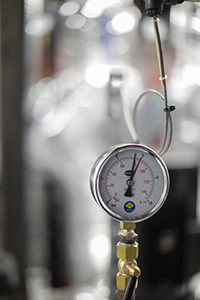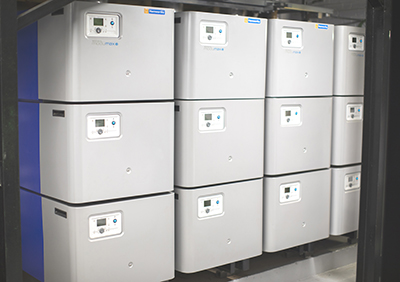Hot property

As mixed use, high-rise developments spring up across our cities, Kevin Potter considers the challenges and options for designing hot water systems in buildings that include homes, offices, gyms and restaurants.
There are currently 21 high-rise buildings in London that are more than 150 metres high, with 14 new ones under construction. Of those, 17% are mixed use. High-rise buildings are already a challenge for heating and hot water systems without the need for extra hot water supply. With an increase of developments which include gyms and showers, it is necessary to carefully weigh up hot water design considerations.
Taking a tall building with centralised plant at ground or basement level as an example, a good working principle is that 1 bar of pressure is required to push water 10 metres vertically. The heating water is usually circulated via booster stations every 10 to 20 floors, using plate heat exchangers and pumps. For example, the heating circuits are pressurised to 6 bar in the basement, pumped to the 15th floor to a set of plate heat exchangers, transferring the heat to a secondary circuit, which is then lifted again to the top of the building or if necessary to another set of heat exchangers transferring the heat to a third circuit. During each transfer heat is lost, which would need to be accounted for in the plant room, meaning higher operating temperatures are required. Obviously, this can and will result in energy loss throughout the pipework and increased energy consumption.
In rooftop plant rooms, gravity takes over by pulling water down (head pressure). However, a simple water tank at the top of a 40-floor building generates excessive pressure at the bottom - a leak near the base of the building could have disastrous consequences. Careful design and planning are needed by either breaking the service on the way down or by using pressure-reducing equipment.
A decentralised approach to the hot water supply means the use of smaller local plant rooms to serve different parts of the building. This allows sections of the building to operate at lower hot water temperatures and reduces the need for large high pressure pumps and/or plate heat exchangers. It also builds in more resilience to the building services if e. g. one boiler should break down it only causes downtime for this section rather than for the entire building. Of course, gas connections and adequate flue routes would be needed for all plant rooms.
 |
Another method of distributing hot water around tall buildings is the use of a medium- or high-pressure hot water system. Heating water is pushed around the building at high pressure and temperature (i.e. 170oC at 10 bar). While the water stays in liquid form under this pressure, heat losses are still inevitable, but the water can be distributed around or up a tall building. Secondary low temperature hot water plant rooms with heat exchangers are also required to transfer the heat into the system at a manageable and safer temperature (e.g. 85°C at a pressure of 2 bar).
Of course it’s important to bear in mind that in the case of a leak, boiling hot steam can injure people and cause serious building damage. All equipment used in the system such as storage vessels, calorifiers, boilers etc. would have to be periodically disassembled, tested and certified for their use and also to comply with insurance rules. For this reason, this type of system is not used as frequently.
While a working environment usually requires 5-6 days a week heating and hot water during normal working hours, extra contingency is still required to allow for extended usage. Flats on the other hand need heating and hot water 24/7, possibly via a centralised plant room circulating low temperature circuits which feed heat interface units.
While normal use of hot water in the office is low and can be satisfied with local point of use of electric water heaters in all bathrooms, provision of showers alongside a gym, or for those who cycle to work, puts additional strain on the hot water supply. If lunch breaks are used for workouts or the gym is open till late, it will add to the hot water consumption as well. Often, large dump loads for hot water use at the same time are needed which can be either satisfied by direct or indirect fired water heaters. If air source heat pumps are installed, a) a direct fired water heater; b) a calorifier with a larger coil surface area to compensate for lower operating temperatures of the heat pump; or c) plate heat exchangers can provide the hot water supply.
The challenge of accurately sizing a hot water system lies in identifying the number of actual users over the peak demand load. This number is often unknown, which requires an amount of diversity to ensure a sufficient amount of hot water. Knowing specific flow rates and types of shower (e. g. on-off or push button; type of shower rose) will help determine a correct sizing.
Siting locations and access will eventually determine the type of hot water generation equipment that can be used. With better-insulated building fabric and boiler turn down ratios increasing, the requirement for turning off boilers in the summer season is reducing. For this reason, indirect fired water heaters are often preferred, as they run off the existing boiler plant, rather than installing additional direct fired units which can take up a lot of space within the plant room.
The use of an existing flue to the boiler can help overcome potential issues of having to install additional flue runs to water heaters (in case they are incompatible). Calorifiers often have larger storage in comparison to direct fired water heaters when looking at a like-for-like kW output, giving a larger dump load and storage safety net at times of higher demand requirements. However, where high demand and fast recovery are required, a good option is a direct fired water heater. Adding an additional storage vessel can help as a backup, but there needs to be allowance for the longer recovery time.
When using a boiler for both heating and hot water, the calorifier coil must be big enough for the boiler to ensure the hot water requirements are met. Higher thermal efficiency from building fabric can often result in the heat load for the hot water to be greater than the demand to heat the building.
Centralised plant rooms are the traditional way to provide heating and hot water to residential buildings. In recent years, we have seen an increase in CHP units operating in combination with modular boilers used as a backup/top-up. Connected to this plant, heat interface units supply individual flats. However, while centralised plant rooms are practical, they also present a single point of failure and can disrupt the heating/hot water supply to an entire building.
 |
High pressure hot water systems are no longer as widely used, as operating them naturally creates more safety implications and higher running costs.
Roof top plant rooms benefit from easy ventilation and a simpler flue route (directly from out of the roof). Often, gravity can do much of the work over pumps. Nonetheless, the logistics of getting plant to the roof top, especially in future years when plant needs replacing needs to be borne in mind. Along with other reasons, excessive pressure generated at lower floors by a large gravity head can also speak against this choice.
With the growth of compact modular boilers, it is often far cheaper to install or convert existing systems to separate smaller low temperature hot water plants rather than maintaining a large centralised plant. The boilers can be easily disassembled into modules and transported via elevators, rather than being craned in, saving considerable costs for road closures and crane hire.
Installing multiple localised plants means the risk is more diversified and the breakdown of one plant does not necessarily affect the others. Additionally, the transfer of heat via shorter pipework distances also reduces heat loss and hence energy wastage.
There is no one-size fits all approach and a suitable system (especially for new builds) should always take height of the building as well as hot water use over time (including peak loads) into account. It is always recommended to keep pipe runs short and storage vessels correctly sized in order to avoid unnecessary heat losses.
Kevin Potter is national sales manager and hot water expert at Hamworthy Heating







